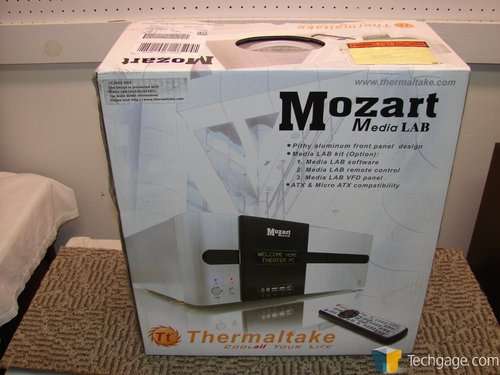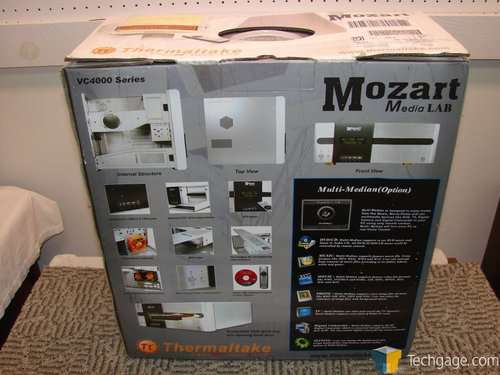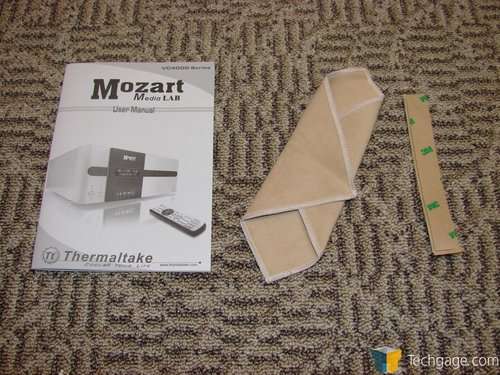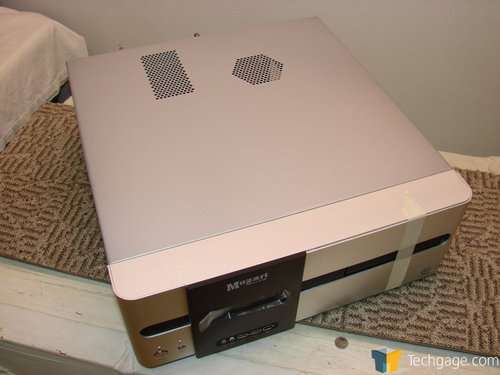- Qualcomm Launches Snapdragon 4 Gen 2 Mobile Platform
- AMD Launches Ryzen PRO 7000 Series Mobile & Desktop Platform
- Intel Launches Sleek Single-Slot Arc Pro A60 Workstation Graphics Card
- NVIDIA Announces Latest Ada Lovelace Additions: GeForce RTX 4060 Ti & RTX 4060
- Maxon Redshift With AMD Radeon GPU Rendering Support Now Available
Thermaltake Mozart VC4000 HTPC Case
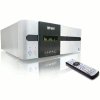
The “Mozart” name implies style and grace, and the Mozart home theater PC case certainly offers elegant styling. But is its beauty only skin deep? Here’s an in-depth look at this popular home theater PC case from Thermaltake.
Page 2 – First Impressions; Specifications
The retail packaging of the Mozart case is what I’ve come to expect from Thermaltake – vivid, with plenty of photos, and an almost comical grasp of the English language. I wonder – is there a shortage of good English translators in China? For a while, the tendency of the Chinese to butcher English speech and writing was a bit endearing, but it’s no longer cute. The box for the Mozart case seems reasonably sturdy. I’ve seen my share of floppy Chinese cardboard, but this is better than most. The rear of the carton displays photos of the case’s notable features.
The case itself is wrapped in a plastic bag, and securely held by two Styrofoam blocks. The package contains all the essentials – the case itself, the instruction manual, a bag of screws and accessories, and a microfiber cloth for wiping off any fingerprints or smudges you may leave behind while assembling the machine. This would have been a nice addition to have with the gloss-black Antec Solo, but smudges and fingerprints are far less noticeable on the Mozart’s silver “Pithy Aluminum” finish.
I removed the case from its plastic bag, and the front door promptly fell open. Unlike the previously-reviewed NZXT Duet, this case lacks the mechanism that softens the opening and closing of the door, so it can fall open with a thud. The styling of the case itself is similar to high-end stereo components made by Classé Audio, though the Mozart’s front corners aren’t as dramatically rounded, so the case won’t look consistent in a stack of Classé components.
In the raised, black-anodized panel near the middle of the case, there’s a tinted plastic window behind which a VFD can be installed, though it isn’t included unless you specifically pick up the Media Lab version of this case.
|
Specification
|
Comment
|
|
| Model | VC4000SNS | In addition to the model name, every Thermaltake product has a somewhat less straightforward model number. Here’s a hint, though – the “SNS” suffix means that this case has a silver finish, and no side windows. |
| Case Type | Media PC Case | Media PC cases are typically no more than horizontal cases that feature front panels more aesthetically consistent with stereo components. This is also true of the Mozart. |
| Exterior Dimensions (H x W x D) |
6.7″ x 16.9″ x 17.8″ (170mm x 430mm x 452mm) |
The Thermaltake Mozart is about an inch deeper than the previously-reviewed Antec NSK2400 case, but a bit taller as well. |
| Cooling Provisions | 2x 60mm rear, 1x 80mm front, included | In media-center PCs, noise is a serious concern. 60mm fans aren’t known for delivering significant amounts of airflow with low noise, so we’ll see how that impacts this case’s thermal performance. |
| Drive Bays | 8 Total 3x 5.25″ External 5x 3.5″ Internal |
The Thermaltake Mozart offers five internal 3.5″ drive spaces, which makes it easy to build in enough storage for a high-capacity media server machine. |
| Material | SECC Steel | This case is made from 0.8mm thick steel, with the exception of the front bezel, which is aluminum but makes little contribution to the case’s structural strength. |
| Expansion Slots | 7 | This case is capable of accommodating a full-size ATX motherboard, with full-height expansion cards. This is done by rotating the ATX power supply 90 degrees. |
| Power Supply | Standard ATX PS2 supported, not included | Given the case’s own meager airflow provisions, you might want to use a power supply with a 120mm or larger fan. |
| Weight | 8.0kg without power supply | This isn’t the heaviest case I’ve experienced, but it’s significantly heavier than the NZXT Duet case reviewed some time ago. It’s also more front-heavy, because of the big aluminum bezel. |
| Motherboard Support |
ATX, Micro ATX | The ability to support a full-size ATX motherboard is a rarity in HTPC cases. The similarly-sized Antec NSK2400 only supports a Micro ATX motherboard. |
| Front I/O Ports | Dual USB 2.0, single IEEE 1394, microphone, and stereo line out | his complement of front I/O ports is fairly standard, so there’s nothing new to report here. |
|
|
Support our efforts! With ad revenue at an all-time low for written websites, we're relying more than ever on reader support to help us continue putting so much effort into this type of content. You can support us by becoming a Patron, or by using our Amazon shopping affiliate links listed through our articles. Thanks for your support!




